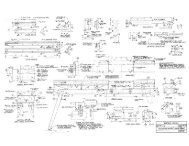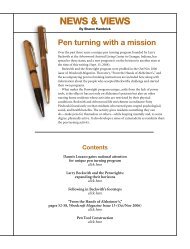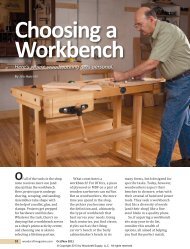40-Woodworking fixes-1b-JH.indd - Woodcraft Magazine
40-Woodworking fixes-1b-JH.indd - Woodcraft Magazine
40-Woodworking fixes-1b-JH.indd - Woodcraft Magazine
You also want an ePaper? Increase the reach of your titles
YUMPU automatically turns print PDFs into web optimized ePapers that Google loves.
10<br />
<strong>Woodworking</strong><br />
Fixes<br />
For projects, tools, and finishes<br />
By Scott Phillips<br />
With over a million viewers tuning in to my<br />
PBS show The American Woodshop, it’s no wonder<br />
that I get a lot of emails and letters containing<br />
woodworking questions on anything from<br />
machining to joinery to inishing. When I get<br />
several questions on the same subject, I like to<br />
ind a venue that helps me provide the answers<br />
in full, helping as many woodworkers as I can.<br />
Here, <strong>Woodcraft</strong> <strong>Magazine</strong> has obliged me in<br />
my responses to some of the more commonlyasked<br />
questions. I divided them into categories:<br />
project solutions, tool talk and ixing inishes.<br />
52 woodcraftmagazine.com April/May 2011
Project Solutions<br />
1 2<br />
Scott, I’ve built some wall<br />
cabinets that I’d like to put<br />
adjustable shelves in, but I<br />
don't want to shell out money<br />
for a hole-drilling jig for the<br />
shelf-pin holes. Any ideas?<br />
—Jason Freemont,<br />
Boulder, Colorado<br />
A dirt-cheap answer may be<br />
buried in your sheet goods stash.<br />
It’s pegboard. Measure the holes,<br />
and you’ll find that they are 1 ⁄4"<br />
diameter and spaced on 1" centers.<br />
Determine where you want your<br />
holes on the cabinet sides, and<br />
rip a pegboard strip to fit in the<br />
cabinet, designating one end<br />
the bottom. Mark the holes you<br />
want to drill on the pegboard,<br />
and clamp it in place. Now, use<br />
this “drilling jig” to drill evenlyspaced<br />
holes. Use a stop collar to<br />
establish the desired hole depth.<br />
I want to take apart an old<br />
chair to restore and refinish it.<br />
What’s the best way to loosen<br />
up a joint containing old glue?<br />
—Ben Ank, Hot Springs, Arkansas<br />
Old or antique furniture joints<br />
typically relied on hide glue.<br />
The bonding agent in more<br />
recent furniture may be yellow<br />
woodworker’s glue (polyvinyl<br />
acetate or PVA). Here, use the same<br />
method for either glue. Reach for<br />
a heat gun or steam iron. Apply<br />
heat or steam around the joint<br />
while loosening the parts. (Clamps<br />
with reversible jaws prove helpful<br />
here.) When you heat the joint<br />
and glue to 200°, you compromise<br />
both types of glues (and possibly<br />
3<br />
the finish). The high heat allows<br />
you to separate the parts.<br />
If you are worried about<br />
damaging the finish, try this. Drill<br />
a hole into the joint, and inject<br />
warm vinegar into the hole and<br />
around the joint with a syringe. Let<br />
the solution soften the glue for 30<br />
minutes. Then separate the parts.<br />
What is the suggested space allowance between and around<br />
inset cabinet doors (those that fit within a face frame<br />
or cabinet opening) when using European hinges?<br />
—John Butler, Midland, Texas<br />
I like a 1 ⁄16" gap all the way around, or something about the thickness<br />
of a nickel. The great thing about European hinges—also known<br />
as concealed hinges—is that you can adjust and tweak the reveal<br />
to be even all around with a few turns of the alignment screws.<br />
Stop collar<br />
4<br />
I’m thinking about buying<br />
a portable lumber mill<br />
that uses a chainsaw. What<br />
are the pros and cons?<br />
—Steve Rogers, Merrill, Georgia<br />
If you have access to hardwood<br />
trees and are in good physical<br />
shape, sawing your own lumber<br />
can be fun and a great way to<br />
save. An inexpensive chainsaw mill<br />
(costing between $<strong>40</strong>-$1,000) can<br />
help you rough-saw boards from<br />
16" wide and up, depending on the<br />
model and size of your chainsaw.<br />
(Check the models at leevalley.com<br />
and norwoodindustries.com.)<br />
Because of the portablility of a<br />
chainsaw system, you can haul<br />
it right into the forest; however,<br />
you’ll then need to carry out wet<br />
boards. Also, be aware that these<br />
systems take time to set up and<br />
require the same precautions and<br />
safety gear for any chainsaw work.<br />
If you have just a few logs to<br />
cut, consider hiring the owner of<br />
a portable bandsaw mill to saw<br />
your material on site. Some charge<br />
by the foot; others, by the hour. To<br />
find one, call Wood-Mizer at (800)<br />
553-0182 or visit woodmizer.com.<br />
Opening photo: Chris Bell; Tip photos: Jim Osborn April/May 2011 woodcraftmagazine.com 53
Tool Talk<br />
5<br />
Is there a cure for “drift” that causes<br />
crooked cuts on the bandsaw?<br />
—Michel Duggan, Springfield, Pennsylvania<br />
Drift describes a bandsaw blade’s tendency to cut to<br />
the left or right of a workpiece cutline when using the<br />
rip fence. Assuming that your guides are adjusted,<br />
and that your blade is properly tensioned, follow this<br />
regimen to correct the problem. Strike a straight line 1"<br />
in from the straight edge of a flat board that’s slightly<br />
longer than the depth of your table. Now, carefully<br />
freehand-cut along the line until the trailing edge of<br />
the board is even with the front edge of your table. Stop<br />
the saw mid-cut, and clamp the board in place without<br />
disturbing its orientation. Place a sliding bevel against<br />
the front edge of the table and the straight edge of the<br />
workpiece, and lock the blade in place, capturing the<br />
“drift angle.” Next, locate the sliding bevel alongside<br />
the fence (locked in place) and against the front edge<br />
of the table. Follow your saw’s manual for loosening the<br />
fence. Now, adjust it to agree with the sliding bevel’s<br />
angle. If using a shop-made wood fence, adjust it as<br />
needed. With the angle secured, make a test cut.<br />
6<br />
I purchased an older tablesaw. The castiron<br />
top is covered with rust. I would like<br />
to know the best way to clean it up.<br />
—Dan Monroe, Blair, Wisconsin<br />
Fact of life, Dan: steel rusts. Sand the top, moving<br />
from 150 to 220 grit using a random-orbit sander.<br />
If needed, scrub any pitted areas with a steel wire<br />
brush and WD-<strong>40</strong> or other lubricant. Once clean,<br />
lubricate and protect the surface with paste wax<br />
or a dedicated commercial sealant. To simply<br />
remove a fine film of rust, pick up a bottle of Empire<br />
TopSaver. This user-friendly product removes rust,<br />
lubricates, and seals metal surfaces (#1480<strong>40</strong>,<br />
8 oz., $19.99). I also like T-9 Rust Protectant for<br />
its similar benefits (#03Q56, 12 oz., $17.99).<br />
54 woodcraftmagazine.com April/May 2011<br />
7<br />
I’m new to woodworking and need to<br />
know what is the best all-around tablesaw<br />
blade? Should I have two blades, one for<br />
hardwoods and one for plywood?<br />
—Paul Pyle, Nampa, Idaho<br />
For an all-purpose quality ripping and crosscutting<br />
blade, go with a <strong>40</strong>-tooth ATB (alternate top bevel)<br />
model or a 50-tooth combination ATBR (alternate top<br />
bevel with raker) blade. Either one of these will handle<br />
90% of the cutting you’ll likely do. Good quality<br />
versions cost in the neighborhood of $80 to $110.<br />
At some point you might want to add other blades<br />
to your collection. For tear-out-free crosscutting<br />
in plywood and panels, pick up a quality 80-tooth<br />
ATB blade in the $120 price range. A flat top<br />
ripping blade in the 24-30-tooth range works well<br />
for general ripping. It will set you back $60.
8<br />
The two pushpads that came with my<br />
jointer make me think that I am applying<br />
uneven pressure to the workpiece<br />
as I pass it over the cutter. Is there a<br />
more effective pushpad I can buy?<br />
—Arnie Brandstad, Gainesville, Florida<br />
There is, and you don’t have to buy it. Using<br />
3<br />
⁄4"-thick plywood and scrap stock, I made this 20"-<br />
long pushblock that gives me complete control when<br />
face-jointing boards under 4' in length. It consists<br />
of a plywood cutout in the shape of a hacksaw<br />
(my template for the design), a pair of glued and<br />
screwed-on strips that serve as the base, and a pusher<br />
cleat at the back end. The shape gives me a long<br />
handle that fits comfortably in both hands. For stock<br />
longer than 4', I employ pushpads to help start the<br />
board through and then finish with my pushblock.<br />
Online Extra<br />
For a simple plan of this jig,<br />
go to woodcraftmagazine.com/<br />
onlineextras.<br />
Finishing Fixes<br />
9<br />
Are there easy ways to remove white<br />
water ring marks on furniture?<br />
—William Owens, Omaha, Nebraska<br />
Absolutely. Items like a hot teapot or a sweaty cool drink can both<br />
result in white rings in a furniture finish. A common way to remove<br />
them is to place a lint-free cloth, such as a T-shirt rag, over the<br />
affected area. Then, with an iron set at medium, iron the cloth. Lift<br />
the cloth to see if the white water stain is gone. Repeat if it’s not.<br />
If worried about damaging the finish, a safer option is Liberon<br />
Furniture Ring Remover (<strong>Woodcraft</strong> #826133, $18.50). Apply the liquid<br />
with a cloth and rub the area in a circular motion. Let dry, then buff.<br />
10<br />
What’s the best way to<br />
finish pine for a blotchfree<br />
appearance?<br />
—Ned Gelinas, Waverly, Virginia<br />
Pine can be a tricky wood to stain.<br />
The lighter, softer earlywood in<br />
pine grain absorbs stain much more<br />
than the harder, darker latewood.<br />
Add in the very absorbent end<br />
grain, and it’s understandable<br />
why many woodworkers simply<br />
clear-finish pine or paint it. I first<br />
sand the pine parts through 220<br />
grit and sand end grain up to 320<br />
grit to help control absorption.<br />
While some use a sanding sealer<br />
for stain control, I wipe on a<br />
nonpenetrating gel stain (such as<br />
Gel Stain by General Finishes); it<br />
builds color without blotching. Try<br />
it on a sample first to see how the<br />
product works. After application,<br />
allow the gel stain to dry for a<br />
day before finishing with your<br />
favorite oil-based urethane. ■<br />
April/May 2011 woodcraftmagazine.com 55










